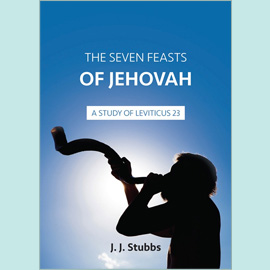One of the ways by which an author or public speaker will seek to maintain the interest of his audience is by the use of illustrations, metaphors and analogies. This is true in secular life, and it is no less true in spiritual matters. Few things are less interesting than a preacher who simply recites his material in a dull monotone, and few things are more captivating than an accomplished orator or writer who by skilful use of imagery makes his message come alive.
The supreme example of this, of course, was the Lord Jesus Himself, who frequently drew on the incidents and events of life on earth in order to make the principles of heaven more vivid in the minds of His hearers.1 Who can forget the picture summoned up by His depiction of needy mankind as being a field white and ready for harvesting (Jn 4.35), or the comparison of the work of the soul-winner to that of the fisherman (Mt 4.19)? In other passages He extends the imagery to His own person, revealing Himself as the "good shepherd" (Jn 10.11), "the light of the world" (Jn 9.5), "the door" (Jn 10.9), and so on. He compared His disciples to the salt that was a hindrance to corruption (Mt 5.13), to the branches that bore the fruit of the vine (Jn 15.5), to a little flock who (in a divine mixing of metaphors!) would receive a kingdom from their Father (Lk 12.32). The simplest and commonest things of daily life could be taken by the Saviour and used as a means of making spiritual truth easier to understand and remember. The shepherd searching the hills of Galilee for a lost sheep (Lk 15.3-6), the farmer sowing the seed in the fields around Nazareth (Mt 13.3-8), the thirst-quenching water drawn from the well (Jn 4.10), the woman searching the house for the lost piece of silver (Lk 15.8-10), the trader bargaining for pearls in the marketplace (Mt 13.45-46): all these, and many others, were taken by Him and shown to have a deeper parallel in the eternal realm. His keen eye perceived the lessons that lay behind every aspect of creation - the foxes in their holes (Lk 9.58), the hen gathering her chicks under her wing (Mt 23.37), the storms that brought down a house built on unstable foundations (Mt 7.26-27).2 What great spiritual lessons there were in these things, waiting to be understood by those who had eyes to see them, and ears to hear!
The followers of the Lord Jesus, too, would use metaphors and analogies as they wrote. The Apostle James, having grown up in the same family as the Lord Himself, fills his epistle with metaphors. The man who is unaffected by his reading of Scripture is likened to one who sees his face in a glass and goes away without making any effort to improve his appearance; the tongue is the helm of a great ship, with the potential to turn the course of a man's life for good or ill, and also a fountain capable of sending forth sweet or bitter water; life itself is as transient as the mist of the morning, vanishing swiftly as the day progresses. Peter, the great apostle to the Jews, is similarly vivid in his expressions: faith is precious gold, able to resist the fire of testing; the Lord Jesus is the sacrificial Lamb, shedding His blood in order that the people of God may be set free from their spiritual bondage; the believer is a new-born babe, filled with a desire for the nutrition of the Word of God, and also a living stone, part of the spiritual house being constructed by the heavenly Builder. John in his epistles uses less imagery than his fellow apostles, but even he portrays himself as a father rejoicing over the development of his children, and looks into the courtroom of heaven to see our Advocate3 and the unchallengeable case that He is able to present. Finally, Jude will take up his pen and depict the ungodly as waterless clouds, promising much but delivering little; as trees having neither root nor fruit; and as foaming waves of the sea, uncontrolled in their restless activity. From beginning to end the New Testament abounds in vivid metaphor and analogy.
Nor is this tendency to use illustrations confined to the New Testament. The prophets and poets of the previous dispensations were men (and women!) of literary skill, weaving their illustrations into their writings with delicacy and power. Job perceives himself to be fine gold, tried in a divine furnace (Job 23.10). David (Ps 1.3) compares the man of God to a fruitful tree, and the ungodly to the worthless chaff driven before the wind; the wicked are wild animals (Ps 22.12,13,16); God Himself is depicted as a shepherd (Ps 23.1), a fortress (Ps 31.3), a rock (Ps 28.1). Israel is a treasured vine (Is 5), a scattered flock (Jer 50.17), a flourishing tree (Hos 14.6-8), and a dismembered corpse (Amos 3.12). Like the New Testament, the Old is filled with a great vividness of language.
However, there is one writer in Scripture who uses perhaps a wider range of metaphors and analogies than any other, and that is the Apostle Paul. He was a man of great literary talent who, under the guidance of the Holy Spirit, drew on his vast experience to produce illustrations of Christian life that would help us to understand divine truth more easily. In these articles we will look at six of the metaphors he uses.
Accountancy
Paul frequently uses the language of accountancy in his writings. Some things in life are profitable, others are to be regarded as losses. In light of this, I should consider how I invest the limited time God has given to me. In the day when I have to give account of myself to God, how will the book of my life balance?
Agriculture
Each of us is sowing something in life, and the great day of assessment will reveal what fruit has been borne as a result of our labours. Let us never forget that we will each reap what we sow. What will the harvest of my life be?
Anatomy
Paul makes frequent use of the human body as a metaphor for the church. The major lessons from this are that each part is necessary, and that the failure of one part affects the whole. Am I functioning in the way that I should?
Architecture
The assembly is often compared to a building, and each of us contributes to it. One day, what I have built will be examined by the great heavenly Architect Himself. Will my work stand the test?
Armour
We sometimes forget that Christian living is a battle, and that we each have foes whose aim is to see us ruined spiritually. God has provided three great types of armour for the believer to use, as we will see in a later article. Do I know how to use them?
Athletics
The life of an athlete requires effort, discipline and endurance in an attempt to win a temporary, earthly prize. In light of the fact that for the believer the incentive is an unfading and eternal reward, how much is my Christian life characterised by effort and discipline?
These are the themes that we will develop in succeeding articles.
Notes
1. We must remember, however, that His parables were not just simple illustrations. They had a double-edged function, in that, while they illuminated the minds of those who had already acknowledged His Person, they were darkness to those who had rejected Him (see Mt 13.10-15). In this, the parables were like the cloud of Exodus 14, which gave light to the people of God while shrouding their enemies in darkness (vv.19-20).
2. Since one of the functions of the created world is to reveal the glory of God and His eternal power and Godhead (Ps 19.1; Rom 1.20), the suggestion by Andrew Jukes that "all creation is a type" is worthy of thoughtful consideration (see Types in Genesis, Part 3.II, Note 17).
3. It is a beautiful detail that the Lord stands as our Advocate, not before the Judge of all the earth, but before the loving and gracious Father of all the family of God.
To be continued.









